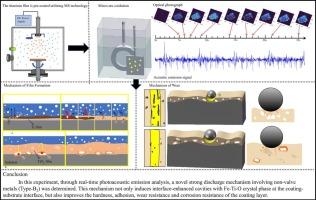Interface-reinforced ceramic films via Type-B2 discharge in micro-arc oxidation: A dual-stage strategy for enhancing wear-corrosion resistance of bearing steel
IF 6.1
2区 材料科学
Q1 MATERIALS SCIENCE, COATINGS & FILMS
引用次数: 0
Abstract
Bearing steel suffers from wear and corrosion failures in service. To enhance its surface performance, the ceramic film was fabricated via magnetron sputtering combined with micro-arc oxidation. Real-time optical-acoustic analysis revealed a novel non-valve-metal based strong discharge mechanism (Type-B2). This mechanism generated interface-reinforced cavities with Fe-Ti-O crystalline phases at the film-substrate interface. Mechanical and electrochemical tests under varying oxidation durations demonstrated that Type-B2 discharged films exhibited an 18.58 % increase in hardness (469 HV vs. 395 HV), 14.29 % longer wear life, and superior corrosion resistance (Ecorr: −0.60563 V vs. -0.64306 V). The enhanced performance was attributed to (1) porosity reduction (18 % decrease in cross-sectional porosity) densifying the structure to inhibit crack propagation; (2) interlocking Fe-Ti-O phases at the interface enhancing adhesion through chemical bonding; and (3) capacitive closed-pore networks blocking ionic transport. This work elucidates the micro-arc oxidation growth mechanism of composite films and demonstrates a surface-protection strategy for bearing steel applications.

微弧氧化b2型放电界面增强陶瓷膜:提高轴承钢耐磨损腐蚀双阶段策略
轴承钢在使用中遭受磨损和腐蚀失效。为了提高陶瓷膜的表面性能,采用磁控溅射结合微弧氧化法制备了陶瓷膜。实时光声分析揭示了一种新型的非金属阀强放电机制(Type-B2)。该机制在薄膜-衬底界面生成了具有Fe-Ti-O晶相的界面增强腔。不同氧化时间下的机械和电化学测试表明,b2型放电膜的硬度提高了18.58% (469 HV vs. 395 HV),磨损寿命延长了14.29%,并且具有优异的耐腐蚀性(Ecorr:−0.60563 V vs. -0.64306 V)。增强的性能归因于:(1)孔隙率降低(横截面孔隙率降低18%),使组织致密化,抑制裂纹扩展;(2) Fe-Ti-O相在界面处互锁,通过化学键增强附着力;(3)阻断离子传输的电容性闭孔网络。本工作阐明了复合膜的微弧氧化生长机理,并展示了一种用于轴承钢的表面保护策略。
本文章由计算机程序翻译,如有差异,请以英文原文为准。
求助全文
约1分钟内获得全文
求助全文
来源期刊

Surface & Coatings Technology
工程技术-材料科学:膜
CiteScore
10.00
自引率
11.10%
发文量
921
审稿时长
19 days
期刊介绍:
Surface and Coatings Technology is an international archival journal publishing scientific papers on significant developments in surface and interface engineering to modify and improve the surface properties of materials for protection in demanding contact conditions or aggressive environments, or for enhanced functional performance. Contributions range from original scientific articles concerned with fundamental and applied aspects of research or direct applications of metallic, inorganic, organic and composite coatings, to invited reviews of current technology in specific areas. Papers submitted to this journal are expected to be in line with the following aspects in processes, and properties/performance:
A. Processes: Physical and chemical vapour deposition techniques, thermal and plasma spraying, surface modification by directed energy techniques such as ion, electron and laser beams, thermo-chemical treatment, wet chemical and electrochemical processes such as plating, sol-gel coating, anodization, plasma electrolytic oxidation, etc., but excluding painting.
B. Properties/performance: friction performance, wear resistance (e.g., abrasion, erosion, fretting, etc), corrosion and oxidation resistance, thermal protection, diffusion resistance, hydrophilicity/hydrophobicity, and properties relevant to smart materials behaviour and enhanced multifunctional performance for environmental, energy and medical applications, but excluding device aspects.
 求助内容:
求助内容: 应助结果提醒方式:
应助结果提醒方式:


